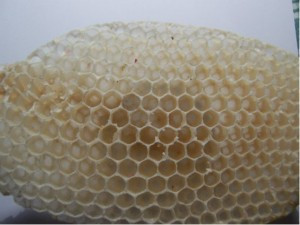Sorry, no results... Try modifying your search: |

From morphology to movement: observation and experiment
Summary
Darwin was a thoughtful observer of the natural world from an early age. Whether on a grand scale, as exemplified by his observations on geology, or a microscopic one, as shown by his early work on the eggs and larvae of tiny bryozoans, Darwin was…

Darwin's in letters, 1873: Animal or vegetable?
Summary
Having laboured for nearly five years on human evolution, sexual selection, and the expression of emotions, Darwin was able to devote 1873 almost exclusively to his beloved plants. He resumed work on the digestive powers of sundews and Venus fly traps, and…
Matches: 3 hits

The evolution of honeycomb
Summary
Honeycombs are natural engineering marvels, using the least possible amount of wax to provide the greatest amount of storage space, with the greatest possible structural stability. Darwin recognised that explaining the evolution of the honey-bee’s comb…
Matches: 1 hits
- … cells – built back to back, and are used to store honey, nectar, and pollen, and to provide a …

A fly on the flower: From Hermann Müller, 23 October 1867
Summary
In March 1867, Hermann Müller, a young teacher of natural sciences at a provincial Realschule (a type of secondary school that emphasised the natural sciences) in Lippstadt in the Prussian province of Westphalia, sent Darwin two papers on the mosses of…
Matches: 1 hits
- … flowers in order to observe their adaptations for collecting nectar and pollen. A letter he wrote in …

Origin: the lost changes for the second German edition
Summary
Darwin sent a list of changes made uniquely to the second German edition of Origin to its translator, Heinrich Georg Bronn. That lost list is recreated here.
Matches: 1 hits
- … It is certain that the hive-bee sucks the nectar out, because I have long since observed many of …

Orchids
Summary
Sources|Discussion Questions|Experiment A project to follow On the Origin of Species Darwin began to observe English orchids and collect specimens from abroad in the years immediately following the publication of On the Origin of Species. Examining…
Matches: 1 hits
- … must be a moth with a long enough proboscis to reach the nectar at the bottom of the flower’s …

Hermann Müller
Summary
Hermann (Heinrich Ludwig Hermann) Müller, was born in Mühlberg near Erfurt in 1829. He was the younger brother of Fritz Müller (1822–97). Following the completion of his secondary education at Erfurt in 1848, he studied natural sciences at Halle and Berlin…
Matches: 1 hits
- … but began looking at the ways insects were adapted to gather nectar and pollen, just as flowers were …

Fool's experiments
Summary
‘I love fools' experiments. I am always making them’, was one of the most interesting things the zoologist E. Ray Lankester ever heard Darwin say. ‘A great deal might be written as comment on that statement’, Lankester later recorded, but he limited…
Matches: 1 hits
- … he suggested that adding ‘ guiding lines ’ to the nectar might attract insects, telling his …

A tale of two bees
Summary
Darwinian evolution theory fundamentally changed the way we understand the environment and even led to the coining of the word 'ecology'. Darwin was fascinated by bees: he devised experiments to study the comb-building technique of honey bees and…
Matches: 1 hits
- … which bore holes in flowers, and thus extract the nectar’ and speculated about this behaviour as an …

Was Darwin an ecologist?
Summary
One of the most fascinating aspects of Charles Darwin’s correspondence is the extent to which the experiments he performed at his home in Down, in the English county of Kent, seem to prefigure modern scientific work in ecology.

Darwin in letters, 1874: A turbulent year
Summary
The year 1874 was one of consolidation, reflection, and turmoil for Darwin. He spent the early months working on second editions of Coral reefs and Descent of man; the rest of the year was mostly devoted to further research on insectivorous plants. A…
Essay: Evolutionary teleology
Summary
—by Asa Gray EVOLUTIONARY TELEOLOGY When Cuvier spoke of the ‘combination of organs in such order that they may be in consistence with the part which the animal has to play in Nature,’ his opponent, Geoffroy St.-Hilaire, rejoined, ‘I know nothing of…
Scientific Networks
Summary
Friendship|Mentors|Class|Gender In its broadest sense, a scientific network is a set of connections between people, places, and things that channel the communication of knowledge, and that substantially determine both its intellectual form and content,…
Matches: 1 hits
- … are adapted to eating pollen rather than only to sucking nectar. He describes such adaptations in …

Darwin in letters, 1860: Answering critics
Summary
On 7 January 1860, John Murray published the second edition of Darwin’s Origin of species, printing off another 3000 copies to satisfy the demands of an audience that surprised both the publisher and the author. It wasn't long, however, before ‘the…

Darwin in letters, 1867: A civilised dispute
Summary
Charles Darwin’s major achievement in 1867 was the completion of his large work, The variation of animals and plants under domestication (Variation). The importance of Darwin’s network of correspondents becomes vividly apparent in his work on expression in…
Matches: 1 hits
- … allowing them to eat pollen-grains as well as suck nectar from flowers they visited ( letter from …


